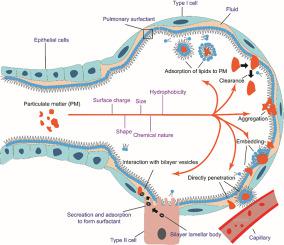Advances in Colloid and Interface Science ( IF 15.9 ) Pub Date : 2020-08-19 , DOI: 10.1016/j.cis.2020.102244 Feifei Wang 1 , Jifang Liu 2 , Hongbo Zeng 3

|
Particulate matter (PM), which is the primary contributor to air pollution, has become a pervasive global health threat. When PM enters into a respiratory tract, the first body tissues to be directly exposed are the cells of respiratory tissues and pulmonary surfactant. Pulmonary surfactant is a pivotal component to modulate surface tension of alveoli during respiration. Many studies have proved that PM would interact with pulmonary surfactant to affect the alveolar activity, and meanwhile, pulmonary surfactant would be adsorbed to the surface of PM to change the toxic effect of PM. This review focuses on recent studies of the interactions between micro/nanoparticles (synthesized and environmental particles) and pulmonary surfactant (natural surfactant and its models), as well as the health effects caused by PM through a few significant aspects, such as surface properties of PM, including size, surface charge, hydrophobicity, shape, chemical nature, etc. Moreover, in vitro and in vivo studies have shown that PM leads to oxidative stress, inflammatory response, fibrosis, and cancerization in living bodies. By providing a comprehensive picture of PM-surfactant interaction, this review will benefit both researchers for further studies and policy-makers for setting up more appropriate regulations to reduce the adverse effects of PM on public health.
中文翻译:

颗粒物和肺表面活性物质的相互作用:对人类健康的影响。
颗粒物 (PM) 是空气污染的主要原因,已成为普遍存在的全球健康威胁。当PM进入呼吸道时,最先直接暴露的机体组织是呼吸道组织细胞和肺表面活性物质。肺表面活性物质是调节呼吸过程中肺泡表面张力的关键成分。大量研究证明,PM会与肺表面活性物质相互作用,影响肺泡活性,同时肺表面活性物质会吸附在PM表面,改变PM的毒性作用。本综述重点介绍了微/纳米颗粒(合成颗粒和环境颗粒)与肺表面活性剂(天然表面活性剂及其模型)之间相互作用的最新研究,以及 PM 通过几个重要方面(例如肺表面活性剂的表面特性)对健康造成的影响。 PM,包括尺寸、表面电荷、疏水性、形状、化学性质等。此外,体外和体内研究表明PM会导致活体氧化应激、炎症反应、纤维化和癌化。通过提供 PM-表面活性剂相互作用的全面概况,本次综述将有利于研究人员进行进一步研究,也有利于政策制定者制定更适当的法规,以减少 PM 对公共健康的不利影响。











































 京公网安备 11010802027423号
京公网安备 11010802027423号